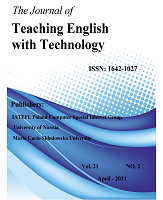THE USE OF VLOGGING TO ENHANCE SPEAKING PERFORMANCE OF ESL STUDENTS IN A MALAYSIAN SECONDARY SCHOOL
THE USE OF VLOGGING TO ENHANCE SPEAKING PERFORMANCE OF ESL STUDENTS IN A MALAYSIAN SECONDARY SCHOOL
Author(s): Shoba Andiappan, Goh Hock Seng, Soo Ruey ShingSubject(s): Foreign languages learning, School education, Distance learning / e-learning
Published by: IATEFL Poland Computer Special Interest Group and The University of Nicosia
Keywords: video-based blogs (vlogs); asynchronous computer-mediated communication; outof-class learning; ESL students; speaking;
Summary/Abstract: This study investigates the effect of a vlogging project on Malaysian ESL students’ speaking performance in a secondary school. Additionally, the students’ experience and perception of making and using vlogs in their language learning were also investigated. To this end, a mixed-methods approach was adopted and the data was collected from 73 participants. A quasi-experiment was conducted to determine the effect of the vlogging project while a questionnaire and a retrospective self-report were utilised to obtain the participants’ views pertaining to their experience in creating vlogs. The findings indicate statistically significant improvement in the ESL students’ speaking scores. Additionally, the participants viewed the vlogging project positively and perceived it as a student-friendly learning tool which can also promote self-evaluation and function as a source of motivation. Drawing on the findings, ESL teachers should consider the pedagogical benefits of vlogs and incorporate them as an instructional technique in the language classrooms. This study indicates that the use of vlogs warrants further research in order to inform the feasibility and pedagogical impact of using vlogs to enhance students’ speaking skills.
Journal: Teaching English with Technology
- Issue Year: 22/2022
- Issue No: 1
- Page Range: 23-39
- Page Count: 17
- Language: English

